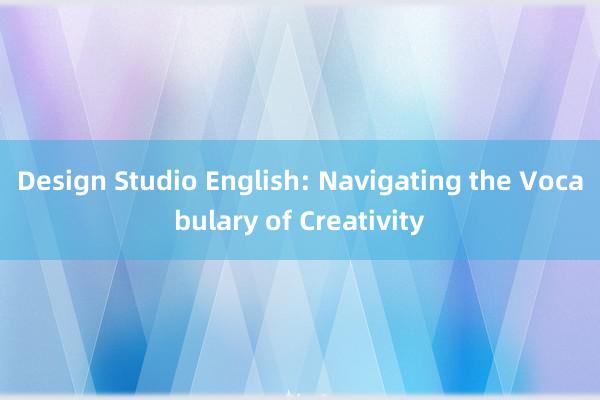
### Design Studio English: Navigating the Vocabulary of Creativity
In the realm of design, creativity is not just an abstract concept but a practical tool that designers wield to transform ideas into tangible outcomes. To fully harness this tool, it's essential to navigate through the specialized vocabulary that forms the backbone of creative discourse in design studios. This article aims to illuminate key terms and concepts, providing a roadmap for those embarking on their creative journeys.
#### 1. **Ideation**
At the heart of any creative process lies ideation, the phase where ideas are generated. It's crucial to understand the various methods used for ideation, such as brainstorming, mind mapping, or using ideation software. Each method has its unique approach to stimulating creativity and generating a wide array of potential solutions.
#### 2. **Prototyping**
Prototyping refers to creating a preliminary version of a product, often with a focus on functionality rather than aesthetics. This step allows designers to test and refine their ideas before committing resources to full-scale production. Prototypes can be physical, digital, or a combination of both, offering flexibility in the design process.
#### 3. **User-Centered Design**
This principle emphasizes designing products with the user in mind,广西联合招商有限公司 focusing on understanding their needs, 泰安人才网_泰安招聘网_泰安人才市场 behaviors, 滨州金汇网业有限公司 and preferences. Techniques like user research, user testing, and empathy mapping are integral to this approach, ensuring that designs meet real-world user requirements and enhance user satisfaction.
#### 4. **Sustainability**
In today’s world,奇迹于你 sustainability has become a non-negotiable aspect of design. This involves considering the environmental impact of materials, production processes, and the lifecycle of a product. Sustainable design principles encourage the use of eco-friendly materials, energy-efficient production methods, and the development of products that can be easily recycled or reused.
#### 5. **Human-Computer Interaction (HCI)**
As technology becomes more integrated into our daily lives, understanding human-computer interaction is crucial. This field focuses on the design of interfaces that facilitate efficient and effective communication between humans and computers. Concepts like usability, accessibility, and user experience (UX) design are central to ensuring that technological solutions are intuitive and inclusive.
#### 6. **Responsive Design**
With the proliferation of devices and screen sizes, responsive design ensures that content and applications adapt seamlessly across different platforms and devices. This approach requires a deep understanding of how to create flexible layouts and interfaces that maintain coherence and functionality regardless of the viewing context.
深圳成达有限公司#### 7. **Brand Identity**
Incorporating brand identity into design projects is vital for establishing a consistent and recognizable presence in the market. This involves creating visual elements like logos, color schemes, typography, and overall aesthetic guidelines that align with the brand's values and resonate with its target audience.
#### Conclusion
Navigating the vocabulary of creativity in design studios involves mastering a diverse set of terms and concepts. By understanding and applying these principles, designers can enhance their ability to innovate, solve complex problems, and create meaningful, impactful designs. Whether you're a seasoned professional or a beginner奇迹于你, continuous learning and exploration of these terms will enrich your design practice and contribute to the creation of innovative solutions that meet the needs of users and the demands of the evolving design landscape.
